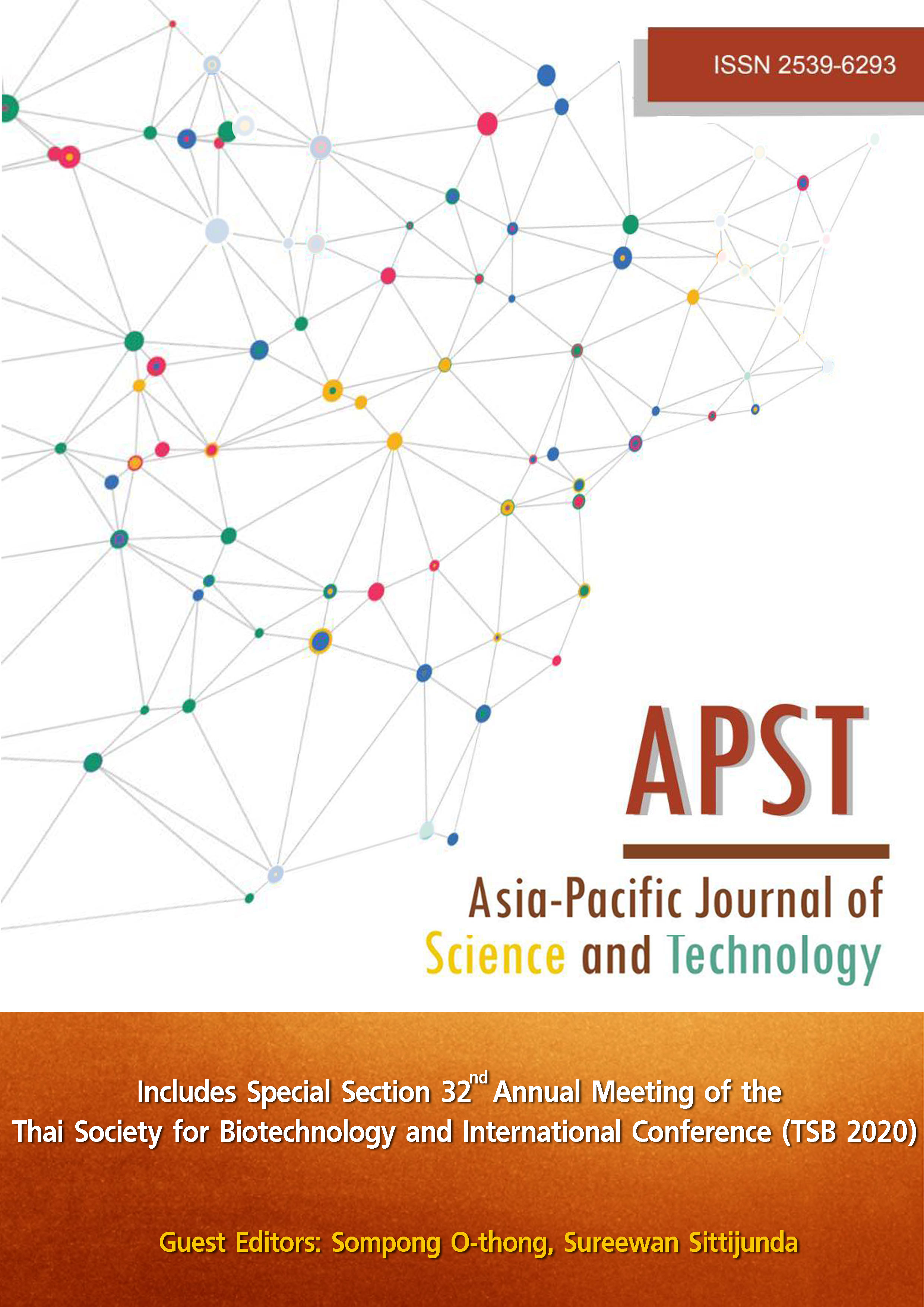Discovery of Aspergillus mycoviruses and development of mycovirus-based vector for gene silencing in the human pathogenic fungus Aspergillus fumigatus
Main Article Content
Abstract
A collection of Aspergillus environmental isolates was screened for the presence of mycoviruses. Out of 178 isolates, 5.1% contained double-stranded RNA (dsRNA) elements ranging in size from approximately 0.7 to 6.0 kbp. The dsRNA elements were identified as belonging to four different categories comprising non-segmented dsRNA, bipartite dsRNA, quadripartite dsRNA and uncharacterized mycoviruses. Aspergillus fumigatus tetramycovirus-1 (AfuTmV-1) was exploited for development as a tool for silencing genes in the human pathogenic fungus A. fumigatus. Using a sequence of dsRNA2 belonging to the AfuTmV-1, a recombinant virus vector was engineered to generate the silencing vector AfuTmV-1-dsRNA2::ALB1 which carried a target ALB1/PKSP gene responsible for spore pigmentation. The engineered virus vector induced loss of conidial pigmentation in the fungal host at different levels and with low frequency. In addition, in vitro translation of mycovirus-based silencing vectors demonstrated that the engineered mycoviral vector was functionally transcribed and translated.
Article Details
References
[2] Nerva L, Chitarra W, Siciliano I, Gaiotti F, Ciuffo M, Forgia M, et al. Mycoviruses mediate mycotoxin regulation in Aspergillus ochraceus. Environ Microbiol. 2019;21(6):1957-1968.
[3] Takahashi-Nakaguchi A, Shishido E, Yahara M, Urayama SI, Sakai K, Chibana H, et ak. Analysis of an intrinsic mycovirus associated with reduced virulence of the human pathogenic fungus Aspergillus fumigatus. Front Microbiol. 2019;10:3045.
[4] Suzuki N, Geletka LM, Nuss DL. Essential and dispensable virus-encoded replication elements revealed by efforts to develop hypoviruses as gene expression vectors. J Virol. 2000;74:7568-7577.
[5] Vetukuri RR, Tian Z, Avrova AO, Savenkov EI, Dixelius C, Whisson SC. Silencing of the PiAvr3a effector-encoding gene from Phytophthora infestans by transcriptional fusion to a short-interspersed element. Fungal Biol. 2011;115:1225-1233.
[6] Panwar V, McCallum B, Bakkeren, G. Host-induced gene silencing of wheat leaf rust fungus Puccinia triticina pathogenicity genes mediated by the Barley stripe mosaic virus. Plant Mol Biol. 2013;81(6):595-608.
[7] Mascia T, Nigro F, Abdallah A, Ferrara M, de Stradis A, Faedda R, et al. Gene silencing and gene expression in phytopathogenic fungi using a plant virus vector. PNAS. 2014;111(11):4291-4296.
[8] Segers GC, Zhang X, Deng F, Sun Q, Nuss DL. Evidence that RNA silencing functions as an antiviral defense mechanism in fungi. PNAS. 2007;104:12902-12906.
[9] Hammond TM, Andrewski MD, Roossinck MJ, Keller NP. Aspergillus mycoviruses are targets and suppressors of RNA silencing. Eukaryotic Cell. 2008;7(2):350-357.
[10] Himeno M, Maejima K, Komatsu K, Ozeki J, Hashimoto M, Kagiwada S, et al. Significantly low level of small RNA accumulation derived from an encapsidated mycovirus with dsRNA genome. Virology. 2010;396:69-75.
[11] Hull R, Covey S. Characterization of cauliflower mosaic virus DNA forms isolated from infected turnip leaves. Nucleic Acids Res. 1993;11:1881-1895.
[12] Coutts RHA, Livieratos I. A rapid method for sequencing the 5’ and 3’- termini of double-stranded RNA viral templates using RLM-RACE. J Phytopathol. 2003;151:525- 527.
[13] Mouyna I, Henry C, Doering TL, Latge JP. Gene silencing with RNA interference in the human pathogenic fungus Aspergillus fumigatus. FEMS Microbiol. Lett. 2004;237:317-324.
[14] Henry C, Mouyna I, Latge JP. Testing the efficacy of RNA interference constructs in Aspergillus fumigatus. Curr Genet. 2007;51:277-284.
[15] Liu H, Cottrell TR, Pierini LM, Goldman WE, Doering T. RNA interference in the pathogenic fungus Cryptococcus neoformans. Genetics. 2002;160:463-470.
[16] Goldoni M, Azzalin G, Macino G, Cogoni C. Efficient gene silencing by expression of double stranded RNA in Neurospora crassa. Fungal Genet. Biol. 2004;41:1016-1024.
[17] Nakayashiki H, Hanada S, Bao-Quoc N, Kadotani N, Tosa Y, Mayama, S. RNA silencing as a tool for exploring gene function in ascomycete fungi. Fungal Genet Biol. 2005;42:275-283.
[18] Ngo H, Tschudi C, Gull K, Ullu E. Doubles stranded RNA induces mRNA degradation in Trypanosoma brucei. PNAS. 1998;95:14687-14692.


